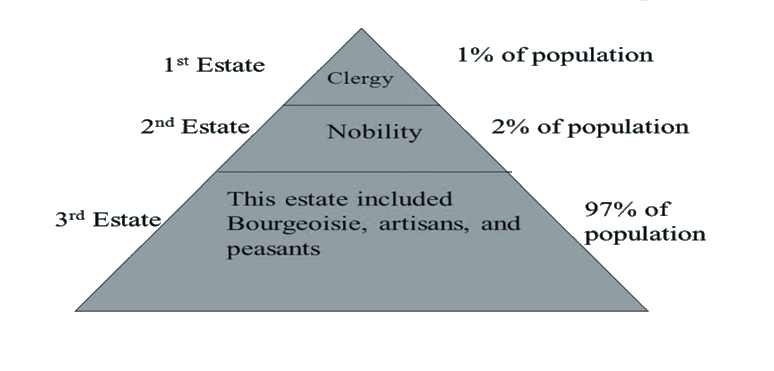Introduction
The French Revolution, which took place in Europe between 1789 and 1799, was a great milestone in European history. The long-term political instability, the dictatorial king, and incompetent bureaucrats who were driven by personal interests rather than the benefit of the common people were the main catalyst for the revolution. In addition, the Third Estate’s enormous tax load and lack of political representation contributed to their which paved the way to a revolution. The revolution started in June 1789 when the Third Estate members declared themselves to be a National Assembly.
Society Structure
France’s socioeconomic structure was based on a feudal system. French society was divided into 3 estates:- the first estate, the second estate, and the third estate.
- First estate- This included the clergy, church priests, etc, as they were involved in religious activities and obligations.
- Second estate- The nobility and aristocracy made up most of the second estate. Most often, this nobility was inherited, although there were times when it could be purchased by paying high taxes and rendering excellent services to the royal class.
- Third estate- Nearly 96 percent of people were members of the Third Estate. There were two groups within the third estate: the first group was made up of businesspeople like big capitalists and advocates. Peasants, labourers, and servants made up the second tier; they were accorded the lowest status in society.
The aristocratic classes of society known as the First and Second Estate owned vast plots of property and were excused from paying taxes. They were supported by the Third Estate, who was entirely taxed to live. The Third Estate members were required to pay tithe and taille. They were also denied representation in the political and social structures despite paying all taxes. Most of the populace in the third estate became unhappy as a result.
A new middle class, which made up the top tier of the third estate, appeared together with the expansion of trade and commerce in Europe. This middle class had grown financially powerful, they were well-educated and wealthy. They began promoting concepts of equality and freedom and rejected the idea of the “Divine right theory of kingship.” They also opposed the church and aristocracy’s abuse of their exceptional privileges, this class demanded political representation that would provide equal chances for all based on an individual’s merits. By the end of the revolution, due to their persistent efforts, a democratic republic was established in France.

Politics
France in the seventeenth century was dominated by a monarchy, the king took all the power into his hands and eliminated public participation in politics.
When King Louis XVI took power in 1774, most of the populace had already grown weary of France’s political unpredictability. Additionally, the royal treasury began to run out due to the monarch’s expensive lifestyle. As a result, the third estate was subject to higher taxes, which infuriated this sector even more. In addition, the French monarchy had zero regard for the well-being of the population. Similarly, unscrupulous, and self-centered administrative officials were ineffective and showed little concern for the welfare of the people.
In the American War of Independence, King Louis XVI dispatched French forces to oppose Britain; this cost many soldiers their lives and increased strain on the treasury.
This made the situation worse and prompted the common people to speak out against the current ruling class and call for a change in the socio-political system in eighteenth-century France.
Summary
The French Revolution of 1789 was a pivotal moment in the history of modern-day West Europe. The social and political structure of France throughout the eighteenth century underwent a significant transformation because of this revolution, which lasted for approximately ten years. Changes were brought about by this revolution not only in France but also in other regions of the world. Other European nations began to overhaul their socio-political institutions following the French Revolution. With the abolition of feudalism in most European nations, the French Revolution had global significance. Although there were many factors contributing to the revolution’s start, social inequality and political unrest were key contributors.
Frequently Asked Questions
How would you define a feudal society?
Ans: Feudalism was a type of socio-political structure that existed in France up to the 18th century. In this arrangement, peasants, or vassals (tenants) received land from landowners or lords in exchange for their duties, primarily the military services to their lords.
What effects did the French Revolution have?
Ans: Following are the effects of the French Revolution:
Establishment of democratic governance.
A political system based on equal rights was developed.
The welfare of the common citizen became a top concern.
All of Europe developed a sense of nationalism as a result.
What were the French Revolution’s founding principles?
Ans: Liberty, equality, and fraternity were the three guiding principles of the French Revolution.
 Mission Statement
Mission Statement
“Empower every student to achieve full potential”
88Guru has been established with the social objective of making quality video-based learning material available to all Indian students. Technology, Connectivity and Social Media are rapidly changing the world of Education and we wish to lead the transformation of the tuition industry in India.
88Guru is the perfect complement to the current tuition model. 88Guru creates a wonderful opportunity for children and parents to bond while engaging in a valuable learning activity. It also provides the complete curriculum at your fingertips for those moments when you need some help at short notice. We believe that this mode of tuition could be transformational, adding hours to a child's day while providing complete control over the learning process.
Every course is taught by the best teachers from India's top schools and conducted in an engaging manner to keep students involved. The e-learning process consists of video-based instructions, computer-graded assignments, and a dashboard which allows the student and parent to track progress.


